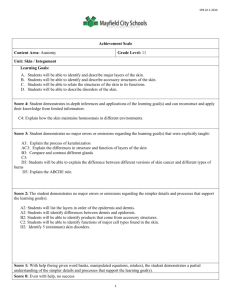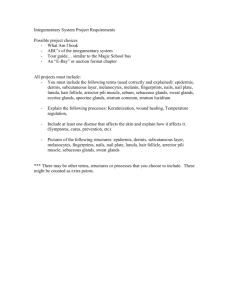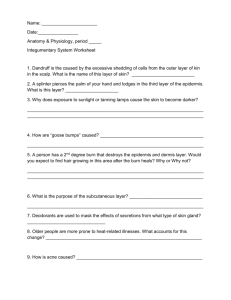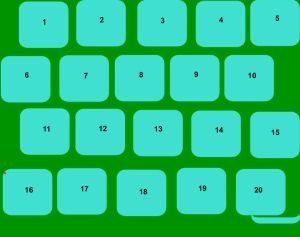CHAPTER 6 (THE INTEGUMENTARY SYSTEM) REVIEW SHEET (using 6
advertisement
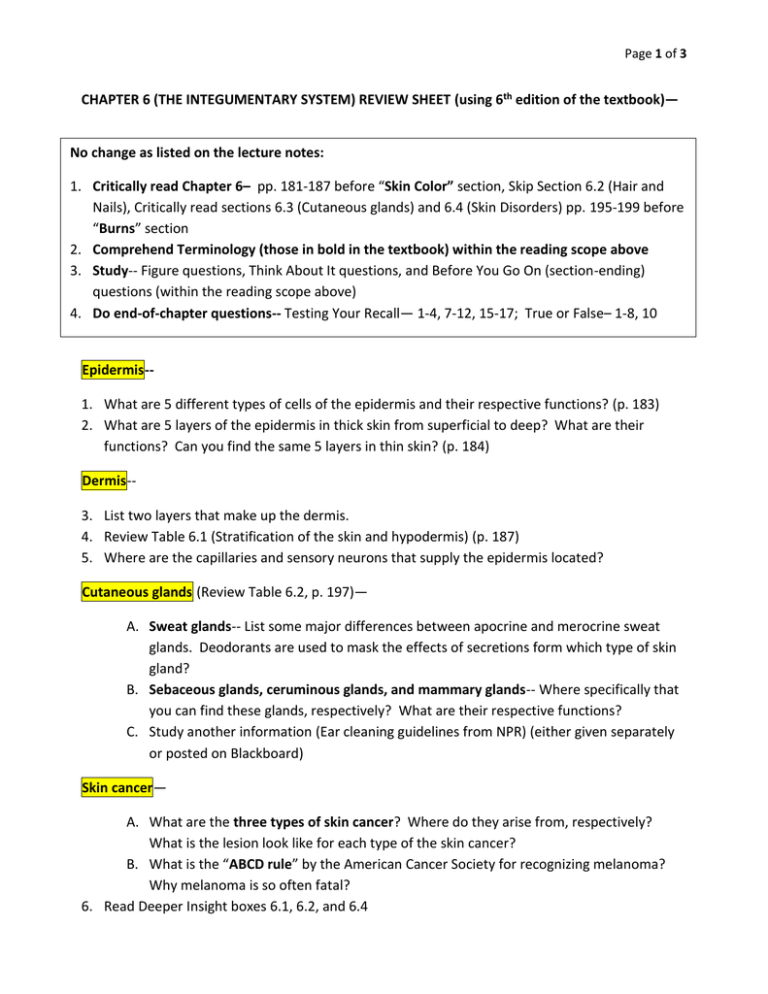
Page 1 of 3 CHAPTER 6 (THE INTEGUMENTARY SYSTEM) REVIEW SHEET (using 6th edition of the textbook)— No change as listed on the lecture notes: 1. Critically read Chapter 6– pp. 181-187 before “Skin Color” section, Skip Section 6.2 (Hair and Nails), Critically read sections 6.3 (Cutaneous glands) and 6.4 (Skin Disorders) pp. 195-199 before “Burns” section 2. Comprehend Terminology (those in bold in the textbook) within the reading scope above 3. Study-- Figure questions, Think About It questions, and Before You Go On (section-ending) questions (within the reading scope above) 4. Do end-of-chapter questions-- Testing Your Recall— 1-4, 7-12, 15-17; True or False– 1-8, 10 Epidermis-1. What are 5 different types of cells of the epidermis and their respective functions? (p. 183) 2. What are 5 layers of the epidermis in thick skin from superficial to deep? What are their functions? Can you find the same 5 layers in thin skin? (p. 184) Dermis-3. List two layers that make up the dermis. 4. Review Table 6.1 (Stratification of the skin and hypodermis) (p. 187) 5. Where are the capillaries and sensory neurons that supply the epidermis located? Cutaneous glands (Review Table 6.2, p. 197)— A. Sweat glands-- List some major differences between apocrine and merocrine sweat glands. Deodorants are used to mask the effects of secretions form which type of skin gland? B. Sebaceous glands, ceruminous glands, and mammary glands-- Where specifically that you can find these glands, respectively? What are their respective functions? C. Study another information (Ear cleaning guidelines from NPR) (either given separately or posted on Blackboard) Skin cancer— A. What are the three types of skin cancer? Where do they arise from, respectively? What is the lesion look like for each type of the skin cancer? B. What is the “ABCD rule” by the American Cancer Society for recognizing melanoma? Why melanoma is so often fatal? 6. Read Deeper Insight boxes 6.1, 6.2, and 6.4 Page 2 of 3 YOUR HEALTH Finally, Guidelines On Cleaning Ears Released From NPR—Sept. 1, 2008 (Morning Edition) Some 12 million people a year seek medical treatment for impacted earwax. Now, the American Academy of Otolaryngology–Head and Neck Surgery Foundation is releasing clinical guidelines on the management of earwax impaction. The guidelines suggest that patients and doctors keep in mind that earwax, technically known as cerumen, is a beneficial, self-cleaning agent with protective properties. It should be removed only when it builds up to a point where it causes symptoms such as pain or hearing loss. Appropriate options for physicians to treat cerumen impaction are: • cerumenolytic (wax-dissolving) agents, such as water or saline • irrigation or ear syringing, a procedure that involves a clinician injecting a stream of water into the ear canal. • manual removal with special instruments or a suction device Inappropriate or harmful interventions are: • inserting cotton-tipped swabs into the ear canal • oral jet irrigators, such as a Waterpik • ear candling, a technique that involves inserting a paraffin coated tube into the ear and then lighting it There are no proven ways to prevent cerumen impaction, but not inserting cotton-tipped swabs or other objects in the ear canal is strongly advised. Individuals at high risk, e.g., hearing-aid users, should consider seeing a clinician every six to 12 months for routine cleaning. Page 3 of 3 A CONCEPT MAP & PRACTICE OF THE INTEGUMENTARY SYSTEM-- Fill in the blanks. Name: ___________________________________; Score: __________ Integument is superficial to Consists of ❶_____________—keratinized stratified squamous epithelium; lacks blood vessels Consists of FIVE TYPES OF CELLS: Dermis—rich in small blood vessels, many collagen and other fibers, cutaneous glands (sweat glands, oil glands, hair follicles), and nerve endings FIVE/FOUR STRATA (TOP TO BOTTOM): ❾________________— between skin and muscle Also called Regions ❷ Mostly _____________ (life span @ 30 days)— secrete keratin Stratum corneum—dead keratinized cells Dendritic (Langerhans) cells—immune cells; fight microbes & pathogens ❹ Stratum _________— only in thick skin; pale appearance due to a clear protein eleidin ❸________________— produce pigment melanin ❺ Stratum _________— forms epidermal water barrier Stem cells— undifferentiated cells give rise to the keratinocytes. ❻ Stratum _________— the thickest stratum in most skin; desmosomes hold cells together Tactile (Merkel) cells/Meissner corpuscle— receptors for touch Stratum basale (single layer) -- include keratinocytes, melanocytes, stem cells, and tactile cells ❼____________ (Superficial) ❽____________ (Deeper) Consists of Consists of Consists of Areolar tissue Dense irregular connective tissue Predominantly ❿__________ tissue Upward dermal papillae interlock with downward epidermal ridges Striae—stretch marks due to torn collagen fibers Subcutaneous layer More areolar tissue than dermis
